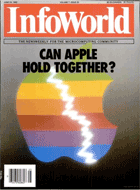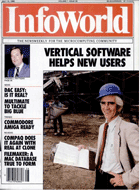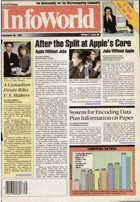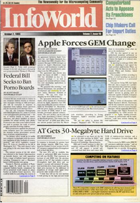Apple Rumors: The Early Years
Hot gossip about the Apple III, the Lisa and "McIntosh," and the company's post-Jobs fate.By Harry McCracken | Monday, September 28, 2009 at 2:13 am
At Least He Lost the Bowtie and Suspenders
 “Shuffle Could Aid Apple,” by Jim Forbes, June 24th, 1985
“Shuffle Could Aid Apple,” by Jim Forbes, June 24th, 1985
As John Sculley forces Steve Jobs out of Apple’s leadership, an anonymous source at the company says it’s no great loss:
I think Apple is moving from one phase of its life to the next. I don’t know how the image of a leader clad in a bow tie, jeans, and suspenders would help us in the coming years.
What happened? For more than a decade, Apple tried multiple other leadership images: a would-be visionary/ex-sugar-water salesman, a hard-working German guy, and a cost-cutting chip-industry executive. Then it went back to Steve Jobs (sans foppish duds), whose image remains one of the most potent marketing tools in the history of tech.
Remember the GE Macintosh? Okay, How About the AT&T Macintosh?
 Inside Track, by John C. Dvorak, July 15th, 1985
Inside Track, by John C. Dvorak, July 15th, 1985
Dvorak discusses early rumors about an Apple buyout (a meme that wouldn’t really heat up until the mid-1990s):
A few weeks ago I was told that General Electric’s Geisco Division was making overtures to buy Apple Computer lock, stock, and (apple) barrel. Those rumors persist with a twist. First of all, I’m told that the AT&T buyout rumors were initiated by a large shareholder to keep the stock high so that the Geisco bid would be high enough for some people to make some money. Geisco, on the other hand, wants to keep the stock depressed so that it can get a good deal. These could, of course, all be bunk rumors to keep Apple stock from falling through the floor.
What happened? As of the last time I checked, Apple remained an independent company. Neither GE nor AT&T is in the PC business, unless you count the modern-day AT&T’s recent foray into netbook retailing. Which doesn’t mean that GE didn’t think about trying to buy Apple in 1985. And Dvorak said he heard the AT&T rumor was spurious.
Steve Jobs in Spaaaaaaaaaaaace!
 “News Desk,” edited by Michael McCarthy, June 29th, 1985
“News Desk,” edited by Michael McCarthy, June 29th, 1985
A story about the Apple II ends with an aside about Jobs’ extracurricular interests:
Meanwhile, someone often accused of overlooking the Apple II is reported by the local press to be asking NASA for a seat on a future space shuttle flight. Apple chairman Steven P. Jobs is said to be a real space buff.
What happened? The idea of Steve Jobs in zero gravity is kind of entertaining, but he’s remained earthbound. In 2007, Charles Simonyi, the father of Microsoft Office, became the first space-tourist computer billionaire.
The Fondly-Remembered Pseudo-Tramiel Era
 “Apple Without Jobs” by Jim Forbes, September 30th, 1985
“Apple Without Jobs” by Jim Forbes, September 30th, 1985
More speculation on post-Jobs Apple, plus exciting news about a machine in the works:
Sculley will also force line managers in Apple’s Production Operations division to be more concerned with procurement and quality control issues. A horizontally integrated Apple could resemble Jack Tramiel’s Atari, the vice president said. One possible Sculley project, expected in 1987, is a small, portable personal workstation, originally developed by the Apple II group, described by one Apple source as a second-generation Dynabook. The machine will accept bit-mapped graphic images over telecommunications lines, said Jean-Louis Gassée, Apple’s director of product development. Such a workstation would overcome some of the current limitations of videotext, seen as a key element in bringing computers into the home.
What happened? I can’t speak to whether Sculley imposed an organizational structure on Apple similar to that favored by the father of the Commodore 64, but I’m glad that Apple showed more staying power than Tramiel-era Atari ever did. As far as I know, the machine described by Jean-LouisGassée never amounted to anything–but if Apple had released it, it sounds like it could have pre-empted the whole darn World Wide Web. (Side note: Can you imagine, even for a millisecond, anyone at today’s Apple discussing a device planned for release in 2011?)
Steve Jobs: A Hard Habit to Break
“The Last Steve Jobs Column–Honest,” by John C. Dvorak, October 7th, 1985
 Dvorak says he’s swearing off writing about Apple’s founder, after one final column on the possibility of competition between Apple and Jobs’ new company, NeXT:
Dvorak says he’s swearing off writing about Apple’s founder, after one final column on the possibility of competition between Apple and Jobs’ new company, NeXT:
And does Apple seriously think Jobs will be competition? Who is Apple kidding? Talk to the real man behind the Macintosh, Jef Raskin, and you’ll get a different picture of Jobs. According to Raskin, Jobs “fought against the design of the Macintosh for two years.” And Jobs was the promoter of the Lisa until it began to flop. So what’s he going to do on his own? Spend a lot of money, that’s all.
(snip)
Maybe when the smoke clears, we will have heard the last from Steve Jobs a guru, seer, visionary, and hapless victim, too. He’ll just be that rich guy in the big house in Woodside. He’ll go the way of the pet rock, electric carving knives, silly putty, Tiny Tim, and the three-tone paint job. Let’s hope so.
What happened? Dvorak–who, despite the column’s title, is still writing Steve Jobs columns a quarter-century later–was right that NeXT involved spending a lot of money without ever providing serious competition to Apple. How about Jobs going the way of the Pet Rock? Er, Dvorak didn’t say it would happen–just that it might, and that he hoped it would. That’s not inaccurate, technically!
Okay, that’s it for now. I could go on, but Sculley-era Apple gossip has its own distinct character, and probably deserves its own story at some point.
Conclusions for now? InfoWorld reported on some rumors that didn’t turn into fact, and sometimes provided analysis that was iffy at the time and wonderfully goofy in retrospect. But it got a decent amount of stuff right, and it presented rumor as rumor rather than fact. And some of the stuff it wrote about that never came to be stemmed from the tendency of multiple Apple bigwigs to blab about unreleased products. Not perfect, but not bad–especially compared to some of the sites that cover the descendants of the gizmos that Apple was making a quarter-century ago.
(Postscript/needless full disclosure: I worked at InfoWorld from 1992 until 1994, and freelanced for it for a few years beyond that. You can find everything I wrote for it at Google Books, but it doesn’t make for particularly entertaining reading.)
More Cupertino-based nostalgia:
«PREVIOUS PAGE 1 2 3
2 Comments
Read more:













September 28th, 2009 at 9:16 am
Hi Harry —
I did not know Google had all those old Infoworlds online. Thanks for the link — it was strange to see all my work from 1990 for the first time in 19 years…
— Paul
September 28th, 2009 at 1:52 pm
Great, wonderful, fantastic excursion down memory lane. You did some incredible research, unearthing a series of gems about the early years. It would have been so cool to have had an Apple II laptop… or a mini-Newton… Sculley probably has a smile on his face given all the discussions about the iTablet– it’s the Knowledge Navigator reborn!
Dvorak certainly played a key role in writing about Apple and contemplating its next moves. (I remember his diatribe or rather satirical take on the original iBook– something about Barbie, cosmetic cases, and being a girlie computer. Of course, it did help save Apple’s bacon! I still enjoy Dvorak today on Cranky Geeks– he’s remarkably funny, personable, and opinionated–and his sidekick Sebastian Rupley is a great foil.)
What’s your sense from having done this about rumors then vs. rumors now? More accuracy, less? More frenzy, less? Better sources, fewer? More insider info vs. sheer speculation?